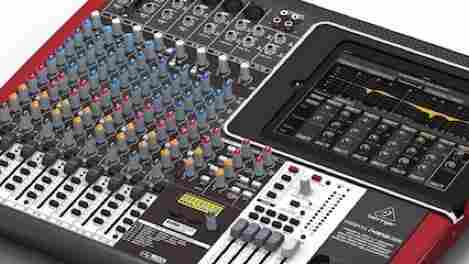Over the past year, corporations have willingly and unwillingly started seeing an increase in tablet usage in big business. While some are quick to embrace the change and adapt to new technologies, others fear the high costs and fail to see the benefits. Corporations waver on policies such as “Bring Your Own Device” v.s. corporate-liable devices due to security and cost reasons.

No matter which policy prevails in the enterprise world, this major shift will shape infrastructure decisions as well as digital strategies. Our friends at Vertic , a digital agency that collaborates with F500s, whipped up this nifty infographic for us on the topic. According to their sources , enterprise tablet adoption is estimated to grow by almost 50% per year as the introduction of Quadcore to tablets, 4G, Cloud Computing and the continuous adoption of HTML5 will make the tablet even more integrated into the work environment
Click on the image for full size.
Warren Goldswain via shutterstock
When toasters fly: what will it take for “smart” appliances to take off?
You’re driving home after a long day at work. You call up your refrigerator and ask it what it suggests for dinner. It says you have just enough ingredients for one of your favorite comfort foods (a medium-rare burger with Swiss cheese, a kaiser roll and ketchup). You tell it to start defrosting the meat, you’ll be home in half an hour.

This kind of stuff was once the exclusive realm of science fiction (as was most of our technological world these days) but the promise of so-called “smart” appliances has been pushed on consumers for a number of years with very little to really show for it . Companies such as LG , Panasonic and GE have brought a number of smarter-than-dumb appliances to market over the last year (and yes, Panasonic does have a microwave and rice cooker that will start cooking for you) but we wouldn’t qualify any of them as really “smart”.
Beyond gimmicks like touchscreens with Pandora and Angry Birds apps (ok, not sure about Angry Birds, but we’re guessing someone somewhere has added it by now), and offering controls via our smartphones “smart” kitchen appliances have mainly focused around food inventory (i “your out of milk” notifications), recipes, and such. While we would really like that burger robotically placed on the table and waiting for us when we walk in the door after being stuck in traffic, there are frankly more pressing needs for most consumers. Most companies right now are betting that first and foremost among those needs is energy cost savings (and of course, that’s good for the environment as well).
Connected appliances that not only notify their owners about how much power they are using but also hook into smart grids (there’s that “smart” word again) in order to optimize power consumption during down non-peak times, is where companies such as GE are focusing. However, connecting to a smart grid only works if there is a smart grid to begin with, and – in the US right now at least – these multi-billion dollar infrastructure improvements are far and few between.
However, even if we assume for a minute that smart grids will be commonplace in the not-too-distant-future, we’re not sure if consumers would really consider simply saving a few dollars per month on their electricity bill as enough of an incentive to pay the premium for a smart appliance that only really benefits them in that way. Also, it would be hard to imagine that once smart grids are commonplace, that there would be any appliances that wouldn’t plug into the smart grid – just like it is now impossible to buy a non-DIY computer today that doesn’t come with Internet connectivity.
Let’s assume that most if not all appliances in the not-so-distant-future connect to the smart grid – so at that point they would be smarter in general than the majority of today’s appliances, but as smart as a smartphone even by today’s standards? Not even close. So then they wouldn’t be smart. They’d be appliances. Which is what we want when we buy, say, appliances. But we want SMART appliances! But then…
We have Moore’s Law, which to us is the real problem at the heart of smart appliances in general. If you’re talking about a Roomba or a Nest Thermostat or some other small connected device, then it is fair to assume that the small appliance (gadget?) hardware in that case would be acceptably updated and replaced somewhere around the timeframe of Moore’s Law. However, if we are talking about a refrigerator or washing machine or dishwasher or oven or water heater or any of the other large ticket items out there, is it really believable that people will be refreshing their hardware in anywhere near the kind of timeline that Moore’s Law follows?
Unless you are the most gadget obsessed person in the world and have a ton of disposable income (i unless you’re Bill Gates) you’re not going to want to waste your time and money on refreshing your suite of clothes and dishwashing appliances every couple of years. These things are sold to last for 10-20 years or longer – are any of us buying our iPads today thinking they’ll be relevant in their current incarnation for that long? Theoretically, a manufacturer might be able to sell a unit that does the thing it was invented to do in say 1908 while offering a replaceable computing unit, but as these things are generally pretty integrated, that seems highly unlikely.
All that said, it’s possible that consumer habits may change – and there is actually a very good precedent: televisions. Back in the days of tube-based televisions, it was common for people to keep their TV sets for quite some time – perhaps not as long as their dishwasher, but certainly more than five years. Today, with both the generally low cost of screens and the near constant improvement in bang-for-the-buck year-in and year-out, TVs really jumped the shark as an appliance and are now firmly in the consumer electronics space. This, of course, means their refresh rates are much closer to following Moore’s Law than present day appliances. If you look at the trend/fad/pipe dream of smart appliances from this angle, you can certainly see why manufacturers are trying to crack the nut on this space – if you’re Maytag, you certainly would rather sell ten washing machines over a twenty year period to someone than just one.
But honestly, what feature could possibly incentivize anyone to replace their washing machine every three or four years? It’s doubtful that any improvement on current washing technology would be enough to do so. That would leave some form of connectivity and processing power that would need upgrading often (and remember – if these things aren’t upgraded regularly, it’s likely they’d be pretty much obsolete within a few years’ time). Perhaps the answer lies in personal and big data.
The one thing that we can think of that might really get people to update their appliances (even if not following Moore’s Law and just as a one-time-upgrade) might just be because of what these appliances could tell us about ourselves. It’s kind of a strange concept, but think for a minute what your washing machine can tell you. Yes, it could tell you how much money you spend a month on electricity and how to optimize that, a la the smart grid mentioned before, but that is just one data point of many.
Your washing machine could contribute data that could be used to answer any number of questions like: “when are you home most often?” (i when you do your laundry); “what is your favorite type and color of clothes?” (which could be easily determined by adding a camera and then pushed offers could be pushed out to your phone while clothes shopping); “what kind of detergent do you use and is it good for the environment?” (again, useful when shopping). You could make a list like this for any number of appliances. We could also choose to send some anonomous data to, for example, heart attack researchers (i what foods do you have in your fridge?). Take all that data and send it to the cloud, blend it together, grind it, send it through the rinse cycle and put it in the oven and who knows what kind of beneficial apps built or discoveries be made that could make our lives easier?
In the end, that’s what appliances are for, right?
P.S. Or, you know, governments may just spy on citizens through their dishwashers…
Image Credit: Yoshikazu Tsuno /Getty Images
Turn your iPad into a serious music-making machine with these new accessories
Those of us who are inclined towards music making are of course aware that the iPad (and to a degree other iOS devices) has started to be viewed as a serious music-making device in the past year.

We’ve been inundated with music apps for the device from straightforward digital audio workstations and sequencers such as Garageband and Nanostudio, to synths like Sunrizer and also innovative ones such as SoundPrism and Gliss. This year however, at NAMM – the twice yearly leading music technology event that takes place in Anaheim, California – its hardware that’s driving the iOS music making revolution forward.
Here’s some of our top picks from the show so far…
I have to admit, I had to suppress a laugh when I first saw an image of one of these, not because they don’t look great – because they do – but just because I thought the idea of a mixing desk that an iPad docks into is too audacious a concept to be real. Turns out I was wrong because this mixer, which comes with either 16, 24, and 32-input channels will be available this year.
Each model will include a USB audio interface, XENYX mic pre-amps, 3-ban channel EQ, one-knob compression on every mono channel and 32 customizable presets including reverb, chorus, and multi-effects powered by the KLARK-TEKNIK FX processor.
Behringer has a reputation as the creator of cheap equipment for amateur musicians and producers and therefore I expect the price of these mixers to be at the right point for people who have invested in an iPad and are looking for the right tool to use for recording music. I also think that these mixers, which can of course also be used with your home studio setup could be great for transferring basic tracks made on the iPad to a desktop based DAW or sequencer.
➤ Behringer iX mixers
While guitarists, vocalist and keyboard player have been slightly spoilt by some of the software and hardware that’s become available for iOS devices, drummers have been a little neglected so far and so its good to see Alesis setting this straight with a dedicated dock for the iPad owning drummer in your life – the DM Dock.
The dock features 13 individual 1/4-inch TRS trigger inputs for connecting drum and cymbal pads and other trigger as well as Traditional MIDI and USB MIDI connections, and an assignable footswitch input are also onboard so you can toggle between kits, tap in a click tempo, or start and stop sequences. Alesis is also bringing out the Alesis Module Mount which allows it to be mounted to any stand or rack.
I expect that, in addition to some of the apps out there already, if this takes off then we’ll see some high quality drum apps coming to the iPad, hopefully even versions of successful plugins like Addictive Drums or EZ Drummer.
➤ Alesis DM Dock
Following in the footsteps of their Synthstation keyboards for the iOS market, Akai has announced an iPad orientated version of their highly regarded MPC controllers that comes in a laptop style case. The MPC Fly, which is designed for the iPad 2 (and presumably future models) has many of the features that make the MPC range great such as velocity sensitive pads, note repeat and MPC swing.
Akai is also releasing an iPad app for the MPC Fly which will allow you to sequence four tracks simultaneously, sample from your iPad’s line-in or mic, and share your creations on SoundCloud, Facebook and Twitter.
I really like the look of this, but be warned if you do too, as Akai does have a history of taking a while to actually get its iOS hardware to the shops, even though it is certainly worth the wait when it arrives.
➤ Akai MPC Fly
If you’ve ever played the electric guitar, then you’ll know that there is nothing quite like stomping on a stompbox and letting rip with some distortion or FX. So, IK Multimedia, which has led the charge into iOS music hardware with its other iRig products, is now looking to make your day.
Designed to work with their popular Amplitube iOS app the iRig stomp allows you to incorporate your iPad into your signal chain (and this mix it with your other FX pedals) and output to your amplifier or PA system and since its durable and light should fit right in with any iPad owning axemasters existing live setup.
Whereas IK Multimedia’s original iRig felt more akin to a tool to practising at home this looks like something you’d certainly want to use live especially since, using Amplitube it could allow you to unleash a great range of FX from your iPad with a single stomp.
➤ iRig Stomp
